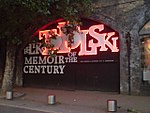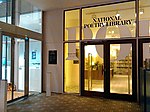Waterloo Air Terminal
Airport terminalsAviation in LondonFormer buildings and structures in the London Borough of LambethHeliports in EnglandUse British English from March 2017

The Waterloo Air Terminal was a passenger reception, check-in facility and heliport on the South Bank of the River Thames in London. It was used by British European Airways (BEA) and other European airlines between 1953 and 1957, when it was replaced by the West London Air Terminal. Passengers checked in, were issued with a boarding card, and were transported to either London Airport or Northolt Airport using a fleet of coaches.
Excerpt from the Wikipedia article Waterloo Air Terminal (License: CC BY-SA 3.0, Authors, Images).Waterloo Air Terminal
York Road, London Lambeth (London Borough of Lambeth)
Geographical coordinates (GPS) Address Nearby Places Show on map
Geographical coordinates (GPS)
| Latitude | Longitude |
|---|---|
| N 51.5038 ° | E -0.116 ° |
Address
Two Southbank Place
York Road
SE1 7ND London, Lambeth (London Borough of Lambeth)
England, United Kingdom
Open on Google Maps










